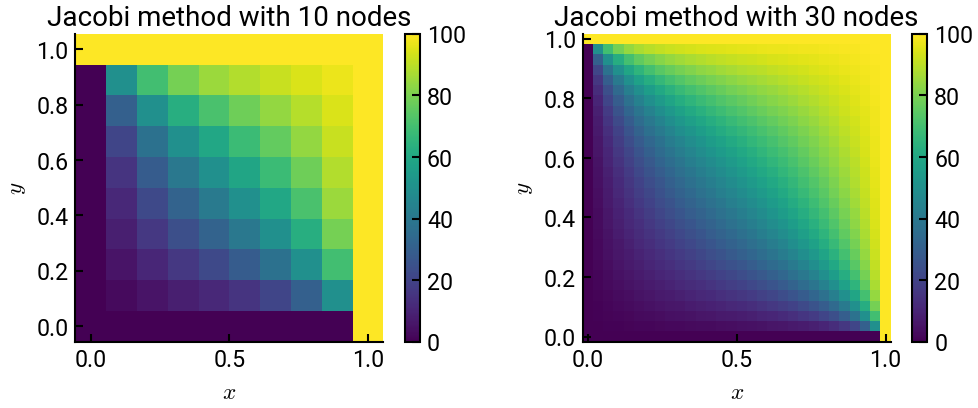12. 2D Laplace equation using iterative methods#
In Exercise 9, we solved the 2D Laplace equation for the steady-state heat distribution using Fourier series. Now, we will show how you can solve the Laplace equation using iterative schemes such as the Jacobi method and Gauss-Seidel method.
Summary of commands#
In this exercise, we will demonstrate the following:
np.meshgrid(x, y)andax.pcolormesh(X, Y, C), as we saw in Exercise 9.using a
whileloop to iterate until convergence.
Demo#

A square cooling plate of length \(1\) is maintained at \(0\) °C. When the machine turns on, two sides are heated to \(100\) °C, as shown in the figure. Using \(10\) nodes and \(30\) nodes, use the Jacobi iteration method to plot the steady-state temperature after the machine turns on, to within a \(1\%\) error. The iteration scheme is
# import libraries
import numpy as np
import matplotlib.pyplot as plt
fig, ax = plt.subplots(ncols=2, figsize=(12, 4))
for k,nodes in enumerate([10, 30]):
# initialize
M = nodes
N = nodes
u = np.zeros((M, N))
u[-1, :] = 100
u[:, -1] = 100
# loop until convergence
error = 1
while error > 0.01:
u_old = u.copy() # make a copy of the old array
for i in range(1, M-1):
for j in range(1, N-1):
# Jacobi updates
u[i,j] = (u_old[i-1,j] + u_old[i+1,j] + u_old[i,j-1] + u_old[i,j+1])/4
error = np.max(np.abs(u_old - u))
# make a plot of the grid
X, Y = np.meshgrid(np.linspace(0, 1, nodes), np.linspace(0, 1, nodes))
h = ax[k].pcolormesh(X, Y, u)
fig.colorbar(h)
ax[k].set(xlabel='$x$', ylabel='$y$', aspect='equal',
title=f"Jacobi method with {N} nodes")
plt.show()

Note
Here we made the choice for the number of nodes quite evident in the shading.
Of course, there are ways to be clever, such as adding shading='gouraud' into ax.pcolormesh() to make the plots look smoother and nearly identical!

